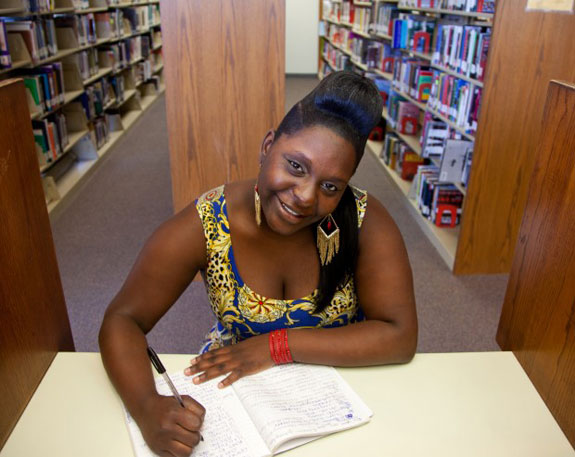<>
Shakira Lockett, 22, spent three semesters taking remedial classes before she began working on college-level courses. Lockett, who attended Miami Dade College’s Wolfson campus in downtown Miami, beat the odds by completing her associate’s degree in mass communications and journalism in May. (Photo by Sagette Van Embden.)
Listen to the companion radio report by Sarah Gonzalez of StateImpact Florida
About This Story: The series “13th Grade” is the result of a collaboration between the Florida Center for Investigative Reporting and StateImpact Florida.
Published on December 3, 2012. :: More than half of high school graduates who took the college placement test in the 2010-2011 school year found out they had to take at least one remedial course in college to boost basic skill. These students couldn’t pass at least one subject on the placement exam used to assess the abilities of incoming students.
Florida’s 28 public community and state colleges are required to accept anyone with a high school diploma or G.E.D.
Students taking remedial classes have a harder time getting through college. They must pay for — and the state must subsidize – these basic-skills courses. They do not receive credit toward graduation for remedial classes, and can’t take courses that do count for credit until their skills improve. The result for these students is a longer path to graduating college.
Many of those students never complete their studies.
The need for remedial education is a nationwide problem. But it’s a significantly worse problem in Florida than elsewhere, despite the state’s reputation as a pioneer in overhauling K-12 education.
Some 54 percent of Florida students who took the state college placement test need remedial work in at least one subject. The national average for first-time students needing remediation is 40 percent.
Demand for remedial courses in Florida has doubled since 2007.
Reducing the number of unprepared students in Florida is critical to the state’s economic recovery for several reasons:
- Remedial education increases the cost of a college degree to students and taxpayers.
- Research shows that students who take remedial classes are less likely to graduate from college than those who arrive ready for college-level work.
- Florida’s economy needs more college-educated workers.
- Without a college degree, workers earn lower wages and contribute less in taxes.
National educators are watching how Florida addresses this problem. The Sunshine State has one of the largest community and state college systems in the country. Randall W. Hanna oversees it.
“There is a cost, a cost to the state, a cost to the student. There’s a cost of time,” said Hanna, chancellor of the Florida College System, which does not include the state’s four-year universities. “We all know if they go into the lower-level math class, they have less of a chance to make it all the way through. We have a real incentive from a cost standpoint to reduce the number of students in developmental education and to make sure they are college ready when they come to our system.”
The Economy’s Effect

One in two Florida students who took the state’s college placement exam in the 2010-2011 school year had to take remedial courses. Those students are less likely to graduate than a student who does not take any remedial classes. (Photo: Flickr.)>>
There are many factors behind the growing crisis of remedial education at Florida’s community and state colleges. Two of them stand out.
One is the Great Recession. The persistently weak job market has produced a surge of displaced older workers at community and state colleges. The number of students aged 20 and older grew by 63 percent between 2003 and 2011. Many of them have been encouraged by the increased availability of federal financial aid.
Some of these older students are going to college for the first time or finishing degrees they never completed. Others are going back to retrain for a different career. Either way, their basic skills tend to be rusty. Older students accounted for 85 percent of those taking remedial courses at Florida’s state colleges in 2010-11.
The subject these students need the most help with is math. Four of every five first-year, full-time students over age 20 had to take remedial math courses, according to the 2011 Florida College System Readiness report using 2009-10 data. For those age 35 and older, the rate increased to 90 percent.
A Skills Gap

<< Researcher Matthew Ladner says that as Florida schools increase their high school graduation rates, more students will likely need remedial classes. (Photo courtesy of EducationNext.org.)
The other big factor is more endemic to public education in Florida. Essentially, there is a disconnect between what students are learning in K-12 schools and what they need to succeed once they get to college.
For more than a decade, under the auspices of reform, Florida has been making dramatic changes to primary education. That included changes in curriculum and graduation requirements aimed at improving student performance in core subjects like reading, math, writing and science.
Standardized tests became more important. The Florida Comprehensive Assessment Test, or FCAT, became more than a measure of student performance. Scores became a determinant of how much state funding schools received or whether they could remain open at all. Starting this year, scores help determine teacher pay.
The overriding goal of these changes was to increase the high school graduation rate – and they did. Though Florida has changed the way it calculates its graduation rates, the rate has risen both before and after the change.
But as it’s turned out, increasing the number of high school graduates is not necessarily the same thing as producing more students who are ready for college.
Policy makers have known this for a while. In 2006, the state Office of Program Policy Analysis and Government Accountability, the research arm of Florida Legislature, found the state’s effort to improve K-12 education hadn’t improved college readiness among students.
At that time, the state agency recommended bridging what it called a “curriculum gap” – the difference between what high school students are taught and what they need to know going into college. Among the problems the OPPAGA report noted included the lack of rigorous high school graduation requirements that go hand-in-hand with college expectations and the need to integrate mathematics and reading to reinforce other courses such as social studies, science and electives.
Measures have only recently been implemented under legislative mandate.
Some education experts lay the blame on the FCAT. Critics say the FCAT’s outsized importance leaves schools little choice but to teach to the test. One of them is Bob Schaeffer, the public education director for the National Center for Fair & Open Testing. He contends that the test interferes with the ability of public schools to prepare students for college.
“When K-12 classes focus on preparation for a narrow, flawed FCAT exam, students are denied the opportunity to master the more sophisticated content and higher-level thinking skills they need to succeed as undergraduates or in the workforce,” Schaeffer said. “The huge percentage of Florida high school graduates who must take remedial courses in college is yet another example of the failure of FCAT-driven public education.”
Matthew Ladner disagrees. He’s a policy and research adviser for Jeb Bush’s Foundation for Excellence in Education, an organization that promotes nationally some of the changes Bush pushed in Florida while he was governor – like increasing emphasis on FCAT scores. Ladner said Florida’s public education has made significant gains in the past decade, thanks in part to high-stakes testing.
“I think people are throwing out the baby with the bath water,” Ladner said. “If you think about what Florida was like before the FCAT, Florida was one of the lowest-ranked states in the country on NAEP.” The NAEP is a national assessment provided to students in grades, 4, 8 and 12 to track student academic progress over time.
To some degree, according to Ladner, Florida’s public education system may be a victim of its own success. He credits the FCAT for increasing the number of high school graduates. Ladner sees it as not altogether unexpected that some of those students would struggle at the college level.
“When you have a substantial increase in graduation rates and you have an increase of kids taking college placement exams, some of these problems would become natural,” Ladner said, referring to the large number of students who can’t pass the college placement exam. “It’s not to diminish that remediation is a problem.”
The Search For Solutions

Lenore Rodicio of Miami Dade College. (Photo courtesy of Miami Dade College.)
Florida has begun to address the remedial education problem. In fact, the number of high school students who are prepared for college work has improved some 10 points since 2003 when 64 percent of high school graduates failed at least one subject on the college entrance exam. Still, state education officials acknowledge that the improvements have fallen short of what’s necessary.
Recent legislative changes have taken aim at the problem. The changes include a creating a new college placement test to identify which subjects current high school students need help with before they get to college; increasing the amount of math instruction high schoolers are required to have in order to graduate; and evaluating students’ college readiness before 12th grade.
Florida also is moving away from the FCAT toward something called the Common Core State Standards. These are academic standards for K-12 students that are supposed to be more aligned to college standards. Forty-five states and the District of Columbia have signed on to the new standards. New curriculum and assessments are being created for Florida based on these standards.
The Florida college system also is revamping remedial courses themselves. The goal is to use computerized classes and other targeted teaching techniques aimed at teaching students the skills they need to continue their college programs. But college educators can do little to prepare students before they reach their campuses.
That’s the point Lenore P. Rodicio repeats over and over again when she speaks at public events. Rodicio is the Vice Provost for Student Achievement Initiatives at Miami Dade College. At her school, 63 percent of high school graduates take at least one remedial course upon enrollment. As Rodicio sees it, receiving a high school diploma today should mean a student is ready for college.
“It’s the case for some students now,” Rodicio said, “but not for everybody.”
In a series of stories this week and throughout December, the Florida Center for Investigating Reporting and StateImpact Florida will explore the growing need for remedial education among Florida’s high school graduates and older students. We’ll try to figure out how we got here and what the state can do to improve public education and provide students with the skills and tools they need to succeed in college and in the workforce.
</>


No comments:
Post a Comment